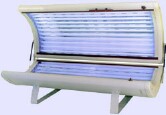
TUESDAY, Oct. 2 (HealthDay News) — Indoor tanning, already associated with an increased risk for the deadliest type of skin cancer, appears to increase the likelihood for other skin cancers as well.
Tanning beds lead to more than 170,000 cases of basal and squamous cell skin cancer each year in the United States. And the earlier you start, the worse the odds, researchers say.
“Not only do tanning beds cause melanoma, the most deadly form of skin cancer, but our study shows they also contribute to the most common cancer, basal and squamous cell skin cancer,” said lead researcher Dr. Eleni Linos, an assistant professor of dermatology at the University of California, San Francisco.
“We could prevent hundreds of thousands of cancers each year by avoiding tanning beds,” she added.
The report was published online Oct. 2 in the BMJ.
For the study, Linos’ team analyzed 12 studies that included more than 9,000 cases of non-melanoma skin cancer, such as basal cell carcinoma and squamous cell carcinoma.
The use of tanning beds was associated with a 67 percent increased risk of squamous cell carcinoma and a 29 percent higher risk of basal cell carcinoma, compared with never using a tanning bed, the researchers found.
Linos’ group estimated that indoor tanning in the United States accounts for about 3.7 percent of cases of basal cell carcinoma (more than 98,000 cases) and 8.2 percent of cases of squamous cell carcinoma (about 72,000 cases) each year.
Moreover, using tanning beds before age 25 appears to significantly increase the risk for basal cell carcinoma, the researchers noted.
Although considered non-malignant, basal cell skin cancer can grow into nearby bone or tissue if not treated. Squamous cell carcinomas spread more than basal cell cancers and can reach the lymph nodes or distant parts of the body, although this is uncommon.
“This study should go a long way to undermining the arguments from tanning bed proponents in the United States regarding studies out of Europe that were criticized by claiming the amount of radiation in Europe is far higher than in the United States,” said Dr. Jeffrey Salomon, an assistant clinical professor of plastic surgery at Yale University School of Medicine in New Haven, Conn.
“This United States-based study shows even if the radiation was less in this country than Europe, the risk remains that tanning beds, on either continent, is an invitation to increase one’s risk of skin cancer,” he said.
Indoor tanning became popular in the 1970s, and studies have shown women, whites and young adults are common patrons. A 2011 survey by the U.S. Centers for Disease Control and Prevention found that nearly 30 percent of white high school girls reported tanning under artificial light.
The practice continues even though major health groups have sounded alarms. The World Health Organization says ultraviolet tanning devices cause cancer, and the International Agency for Research on Cancer lists indoor tanning as a Class 1 carcinogen, along with tobacco and asbestos.
A European study published in the July 24 issue of the BMJ, concluded people who use tanning beds face a 20 percent increased risk of skin cancer, and that raised risk reaches 87 percent if indoor tanning starts before age 35.
“Indoor UV tanning devices are real carcinogenic devices, and people should be advised not to attend indoor tanning parlors or to buy them for private use,” said the lead author of that study, Philippe Autier, director of the International Prevention Research Institute in Lyon, France.
John Overstreet, executive director
of the Washington, D.C.-based Indoor Tanning Association, which represents the tanning bed industry, noted in a statement Tuesday that basal cell and squamous cell cancers are easily treated.
He added that studies such as these focus on the negatives, and never the positives of indoor tanning.
“While indoor tanning is generally considered a cosmetic activity, there are also proven and published health benefits of vitamin D production, which many researchers believe outweigh the overall health risks of skin cancer and even melanoma,” Overstreet said.
However, he added that tanning, whether indoors or outside, needs to be done in moderation.
Some indoor-tan proponents maintain that the tanning technology has improved over time, but the researchers say both UVA and UVB exposure are dangerous.
More information
For more information on skin cancer, visit the American Cancer Society.

